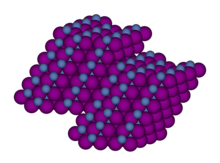This is an old revision of this page, as edited by CheMoBot (talk | contribs) at 22:37, 12 May 2011 (Updating {{chembox}} (no changed fields - added verified revid - updated 'UNII_Ref', 'ChemSpiderID_Ref', 'StdInChI_Ref', 'StdInChIKey_Ref', 'ChEMBL_Ref', 'KEGG_Ref') per Chem/Drugbox validation (). The present address (URL) is a permanent link to this revision, which may differ significantly from the current revision.
Revision as of 22:37, 12 May 2011 by CheMoBot (talk | contribs) (Updating {{chembox}} (no changed fields - added verified revid - updated 'UNII_Ref', 'ChemSpiderID_Ref', 'StdInChI_Ref', 'StdInChIKey_Ref', 'ChEMBL_Ref', 'KEGG_Ref') per Chem/Drugbox validation ()(diff) ← Previous revision | Latest revision (diff) | Newer revision → (diff) | |
 | |
| Names | |
|---|---|
| IUPAC name Nickel(II) iodide | |
| Other names Nickelous iodide | |
| Identifiers | |
| CAS Number | |
| ECHA InfoCard | 100.033.319 |
| PubChem CID | |
| CompTox Dashboard (EPA) | |
| Properties | |
| Chemical formula | I2Ni |
| Molar mass | 312.5023 g·mol |
| Appearance | black solid, hydrate is green |
| Density | 5.38 g/cm |
| Melting point | 780 °C (1,440 °F; 1,050 K) |
| Boiling point | 797 °C (1,467 °F; 1,070 K) |
| Solubility in water | good |
| Solubility | alcohols |
| Hazards | |
| NFPA 704 (fire diamond) |
 |
| Related compounds | |
| Other anions | nickel(II) chloride, nickel(II) bromide, nickel(II) fluoride |
| Other cations | cobalt iodide, copper iodide, |
| Except where otherwise noted, data are given for materials in their standard state (at 25 °C , 100 kPa).
| |
Nickel(II) iodide is an inorganic compound with the formula NiI2. This paramagnetic black solid dissolves readily in water to give blue-green solutions of the aquo complexes. This blue-green colour is typical of hydrated nickel(II) compounds. Nickel iodides find some applications in homogeneous catalysis.
Structure and synthesis
The anhydrous material crystallizes in the CdCl2 motif, featuring octahedral coordination geometry at each Ni(II) center. NiI2 is prepared by dehydration of the pentahydrate.
NiI2 readily hydrates, and the hydrated form can be prepared by dissolution of nickel oxide, hydroxide, or carbonate in hydroiodic acid. The anhydrous form can be produced by treating powdered nickel with iodine.
NiI2 has found some industrial applications as a catalyst in carbonylation reactions. It is also has niche uses as a reagent in organic synthesis, especially in conjunction with samarium(II) iodide.
References
- Lide, D. R., ed. (2005). CRC Handbook of Chemistry and Physics (86th ed.). Boca Raton, Florida: CRC Press. ISBN 0-8493-0486-5.
- Laird G. L. Ward, "Anhydrous Nickel (II) Halides and their Tetrakis(Ethanol) and 1,2-Dimethoxyethane Complexes" Inorganic Syntheses, 1972, Volume 13, Pages: 154–164, 2007. doi:10.1002/9780470132449.ch30
- W. Bertleff, M. Roeper, X. Sava, “Carbonylation” in Ullmann’s Encyclopedia of Industrial Chemistry, Wiley-VCH: Weinheim, 2003. DOI: 10.1002/14356007.a05 217.
- Shinichi Saito, Nickel(II) Iodide" in Encyclopedia of Reagents for Organic Synthesis, John Wiley & Sons, 2008. DOI: 10.1002/047084289X.rn00843. Article Online Posting Date: March 14, 2008.
| Nickel compounds | |
|---|---|
| Nickel(0) | |
| Nickel(II) | |
| Nickel(III) | |
| Nickel(IV) | |
This inorganic compound–related article is a stub. You can help Misplaced Pages by expanding it. |